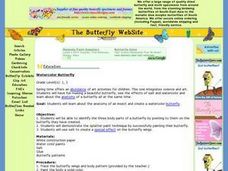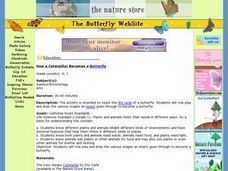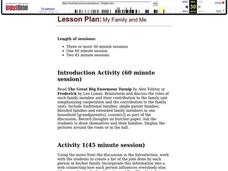Curated OER
Presto Change-o: Caterpillars to Butterflies
Students use the Internet to explore the four stages of a butterfly's life cycle. They make a model of a butterfly using macaroni, sticks and leaves.
Curated OER
Birth of a Butterfly
Learners demonstrate an understanding of insects and science as a whole and construct the life cycle of a butterfly using pasta. They first fold a piece of paper into four equal parts. In the upper left corner will be stage one (egg)....
Curated OER
Picture Scramble
In this science worksheet, pupils examine 3 pictures of an insect, frog and tree. Next to each picture, there is the same image which has been divided into 9 pieces and scrambled. Students put the pictures in order by numbering them...
Curated OER
Forests
Learners examine soil in forests looking for animals and insects. They divide the animals based on their number of legs and draw the animal they have collected.
Curated OER
Watercolor Butterfly
Students identify and analyze the anatomy of an insect and create a watercolor butterfly. They identify the three body parts of a butterfly by pointing to them on the butterfly they have created and demonstrate the splatter paint...
Curated OER
How a Caterpillar Becomes a Butterfly
Student role play and draw the various stages an insect goes through to become a butterfly. They discover the different stages of how a caterpillar becomes a butterfly. Young scholars read The Very Hungry Caterpilla by Eric Carle.
Curated OER
Earthworms Page 1 and 2
In this word search worksheet, students locate 17 words related to earthworms. Words include decayed, present, similar, waste, enemies, and insects.
Curated OER
Butterflies
In this insects worksheet, students look over 6 different pictures of butterflies, name each butterfly and then find out what else they can find out about each one.
Curated OER
Animal Types
In this animal vocabulary instructional activity, students categorize the list of animals according to their type: mammals, birds, reptiles, amphibians, fish, and insects.
Curated OER
Animals at Night
In this nocturnal animals worksheet, students study a fact page with lists of mammals, insects, birds and amphibians that they may see on the school grounds at night. There are no questions to answer.
Curated OER
Food Chain Worksheet
In this food chain worksheet, students circle organisms that complete food chains shown, 5 total. All chains begin with the sun and move through insects, plant life and animals.
K12 Reader
Rainforest Ecosystems
Rainforests are the topic of this brief reading passage. Learners can find out all about the different layers of the rainforest as well as the types of creatures that live there. After reading, they respond to five questions about the text.
K12 Reader
What’s Eating You?
Introduce your class to producers, consumers, and pollinators with a reading passage. Class members read the text and respond to five related questions.
Curated OER
Ant Lion Lesson Plan
Young scholars observe three qualitative and quantitative observations. The students further practice the follwoing: asking research questions,forming a hypothesis, and describe how ant lions catch their prey. Young scholars also form...
Curated OER
Co-evolution of Plants and Pollinators
Students, while studying the rolls of pollinators and plants, explore co-evolution of mutualistic relationships.
Curated OER
Build Your Own Bug
Students create a unique bug. In this lesson plan about bugs, students use their imagination to develop a new kind of bug. Students use construction paper, scissors, glue, and crayons to make their bug. Students explore the different...
Curated OER
Boy Cricket Girl Cricket
Students investigate crickets. In this series of cricket activities, students observe and chart crickets. Students discuss the differences between male and female crickets, record findings in a journal, handle crickets, and read a...
Curated OER
Grooming Is A Good Thing
Students construct fly traps, collect house flies, and observe the flies grooming. They compare/contrast the fly's grooming techniques with their own. They develop a good grooming habits chart.
Curated OER
Comparing Minibeasts
In this "Comparing Minibeasts Data Worksheet", students respond to four short answer, one drawing, and eight graphic organizer questions.
Curated OER
Honey Bee Anatomy and Identification
Students examine and dissect a worker honey bee to analyze the structures and functions of honey bees. They draw the structures they see and compare/contrast them to drawings or electron micrographs.
Curated OER
What Bees Eat
Students study plant and animal interdependence by studying bees and pollination. In this interdependence lesson, students discuss flower parts and dissect it to show its reproductive parts. Students then use tissue and pipe cleaners to...
Curated OER
Songs And Stories About Bees
Students study bees. In this nature lesson, students practice a busy bee song, read poems about bees, and discuss the concept of beekeeping.
Curated OER
My Family and Me
Learners discuss the family unit and compare it to an ant colony. In this family lesson plan, students draw their family and extended family and talk about their jobs and family roles. They compare this to an ant colony and observe the...
Curated OER
Major Functions
Seventh graders investigate the basic characteristics and needs of living things. They identify the major parts of plants and animals by making lists. Students focus upon one living thing and speculate how if one part is changed how it...
Other popular searches
- K 2 Life Science Insects
- Science Insects
- Parts of Insects Science
- Life Science Insects
- Science Spiders vs Insects
- Esl Lessons Science Insects
- Esl Science Insects

























